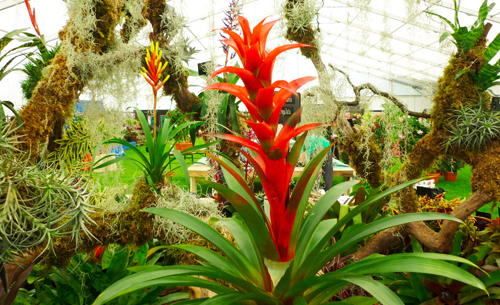How to Grow Bromeliads

In Britain Bromeliads in general, will need to be grown indoors, either in a conservatory or glasshouse. Recently a genus of Fasicularia has become commercially available that is hardy to our climate, but the vast majority will need a minimum temperature of 45 Degrees F. (8 deg C).
To give accurate information on the growing of Bromeliads is down to the species that you may be interested in growing.
Most Bromeliads like natural light, which is important to the well being of the plant. Terrestrial Bromeliads (ground dwellers), such as Puya and Dykia and hard or grey-leaved epiphytes (plants that live on trees or in the air), such as Tillandsias, Aechmeas and Billbergias can tolerate full light as this will encourage strong growth.
Other Bromeliads such as Neoregelia and Guzmania require a little more shade. While the soft-leaved types such as some Aechmea,vriesia and Nidularium are better in a semi- shaded position.
The epiphytic types can be grown as a potted plant, but will lend themselves to growing on a bit of rough wood even better. In a pot the compost would be better if it was mostly a rough bark media. if you are going to grow Bromeliads in a pot then if possible use clay pots, these are more porous and dry out quicker than plastic which suit the growing of the Bromeliad.
The root system on epiphytic plants are only used to cling on and hold to what ever surface it is on (rocks or trees), the nutrients and water are taken in through the reservoir of water that is held in the base of the plants leaves. Even though the plant will take water through the base of the leaves it is important to keep the roots moist this will prevent scorch marks on the leaves. Never over water as this will cause the plant to suffer, in the winter do not allow water to stay in the reservoir, tip it out, if not, the cooler temperatures could damage new growth. When watering bromeliads always use rainwater for preference.
In the growing season a feed every 10 to 14 days should be sufficient, use a balanced but veryweak solution a strong mixture of feed may damage the absorbent cells at the base of the leaves,.
Propagation of most Bromeliads is quite straightforward. Once the Bromeliad nears the end of its flowering period it starts to send up small shoots at the base of the plant. These then can either be cut or replanted to produce another plant or can be kept on the plant to replace the dying mother. The mother once flowering has finished can then be cut and removed, leaving space for the new shoots (pups) to grow in its place.
We have been undertaking trials with some of the tougher varieties and growing them under cool to very cool conditions to see what they will tolerate. Some plants have even been left outside. the adaptability of some has been quite surprising. It is too early to recommend any variation in the growing advice above as yet.